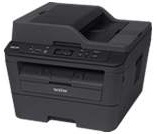
The Brother DCP-L2540DN is a versatile printer that is similar to the DCP-L2560DW, but with some minor variations. It belongs to a family of printers that includes the DCP-L2540DN, MFC-L2720DW, DCP-L2500D, DCP-L2520DW, MFC-L2700DW, and MFC-L2740DW. The DCP-L2540DN has an internal memory of approximately 32 MB of RAM.
Brother DCP-L2540DN printer driver for Windows
| Filename | Size | Download |
| Printer Full Drivers for Windows 7 8 8.1 10 vista xp 32 bit and 64 bit.EXE | 165.64 MB |
Brother DCP-L2540DN driver for Mac
| Filename | Size | Download |
| Printer Full Drivers for Mac 10.14.dmg | 344.23 MB | |
| Printer Full Drivers for Mac 10.9 to 10.13.dmg | 344.48 MB | |
| Printer Full Drivers for Mac 10.8.dmg | 344.56 MB | |
| Printer Full Drivers for Mac 10.7 to 10.11.dmg | 22.35 MB |
Specifications
This device boasts a TFT color touchscreen liquid crystal display (LCD) that measures about 2.7 inches (or 67.5 mm) diagonally. The touchscreen supports a variety of characters, totaling about 16, and has two lines for easy navigation. When it comes to print language compatibility, it supports PCL6 and BR-Script3 (a Postscript 3). The print resolution is around 600 x 600 dots per inch (dpi), with a maximum resolution of 2400 x 600 dpi for top-notch quality.
The duplex component of the printer offers automatic printing on both sides of the page, enhancing efficiency in document printing. The duplex printing rate varies depending on the document complexity, with an average of 7.5 sheets per minute on A4 size. In contrast, the standard print speed is approximately 30 pages per minute on an A4, with a first-page printing time of less than 8.5 seconds at a temperature of 230C.
When it comes to connecting with this device, you have three primary choices at your disposal. The first and most common option is the main universal serial bus (USB), which can be accessed through the hi-speed USB 2.0 port. It’s worth noting that the USB cable you use should be the recommended one from the manufacturer and should not exceed 2.0 meters in length.
Alternatively, you could opt for a LAN connection to facilitate networking. This option requires the use of 10BASE-T or 100BASE-TX components, along with a straight-through category 5 cable or higher.
Ultimately, the decision of which connection type to use will depend on your specific needs and preferences. Each option has its own unique advantages and drawbacks, so it’s important to weigh them carefully before making a choice. Regardless of which option you choose, however, it’s crucial to ensure that your setup is properly configured and optimized for optimal performance.
In addition to its impressive printing capabilities, this device boasts seamless Wireless connectivity through IEEE 802.11b/g/n in a regular infrastructure, Ad-hoc, or WI-Fi direct. It’s important to note that third-party USB is not supported on this printer. The printer also supports a variety of network protocols, such as WINS/NetBIOS, DNS, ARP, RARP, DHCP, BOOTP, and more.
